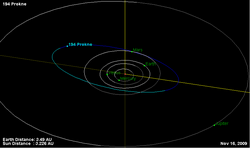Astronomy:194 Prokne
 Orbital diagram | |
| Discovery | |
|---|---|
| Discovered by | C. H. F. Peters, 1879 |
| Discovery date | 21 March 1879 |
| Designations | |
| (194) Prokne | |
| Pronunciation | /ˈprɒkniː/[1] |
| Named after | Procne |
| A879 FA | |
| Minor planet category | Main belt |
| Adjectives | Proknean /prɒkˈniːən/[2] |
| Orbital characteristics[3] | |
| Epoch 31 July 2016 (JD 2457600.5) | |
| Uncertainty parameter 0 | |
| Observation arc | 136.76 yr (49950 d) |
| |{{{apsis}}}|helion}} | 3.2386 astronomical unit|AU (484.49 Gm) |
| |{{{apsis}}}|helion}} | 1.9930 AU (298.15 Gm) |
| 2.6158 AU (391.32 Gm) | |
| Eccentricity | 0.23810 |
| Orbital period | 4.23 yr (1545.3 d) |
| Mean anomaly | 42.282° |
| Mean motion | 0° 13m 58.692s / day |
| Inclination | 18.509° |
| Longitude of ascending node | 159.32° |
| 163.24° | |
| Earth MOID | 0.986917 AU (147.6407 Gm) |
| Jupiter MOID | 2.15988 AU (323.113 Gm) |
| TJupiter | 3.295 |
| Physical characteristics | |
| Dimensions | 168.42±4.1 km[3] 170.33±6.92 km[4] |
| Mass | (2.68±0.29)×1018 kg[4] |
| Mean density | 1.03±0.16 g/cm3[4] |
| Rotation period | 15.679 h (0.6533 d)[3][5] |
| Geometric albedo | 0.0528±0.003 |
| C | |
| Absolute magnitude (H) | 7.68 |
Prokne (minor planet designation: 194 Prokne) is a main-belt asteroid that was discovered by German-American astronomer C. H. F. Peters on March 21, 1879, in Clinton, New York, and named after Procne, the sister of Philomela in Greek mythology. Stellar occultations by Prokne have been observed twice, in 1984 from Italy and again in 1999 from Iowa (United States).
Observations from the W. M. Keck Observatory show the asteroid to be around 151 km across, with a size ratio of 1.13±0.06 between the major and minor axes. For comparison, observations by the IRAS observatory gave a diameter of 164 km.[6] The spectrum matches a classification of a C-type asteroid, indicating it has a primitive carbonaceous composition. Judging from radar data, the near surface solid density of the asteroid is 3.6+1.1−0.9 g cm−3.[7]
Based upon a light curve that was generated from photometric observations of this asteroid at Pulkovo Observatory, it has a rotation period of 15.679±0.001 hours and varies in brightness by 0.16±0.02 in magnitude.[5]
References
- ↑ "Procne". Procne. Oxford University Press. http://www.lexico.com/definition/Procne.
- ↑ Harris & Lee (2004) Shakespearean criticism, p. 113
- ↑ 3.0 3.1 3.2 Yeomans, Donald K., "194 Prokne", JPL Small-Body Database Browser (NASA Jet Propulsion Laboratory), https://ssd.jpl.nasa.gov/sbdb.cgi?sstr=194, retrieved 12 May 2016.
- ↑ 4.0 4.1 4.2 Carry, B. (December 2012), "Density of asteroids", Planetary and Space Science 73: pp. 98–118, doi:10.1016/j.pss.2012.03.009, Bibcode: 2012P&SS...73...98C. See Table 1.
- ↑ 5.0 5.1 Pilcher, Frederick (October 2011), "Rotation Period Determinations for 11 Parthenope, 38 Leda, 111 Ate 194 Prokne, 217 Eudora, and 224 Oceana", The Minor Planet Bulletin 38 (4): pp. 183–185, Bibcode: 2011MPBu...38..183P.
- ↑ Marchis, F. et al. (November 2006), "Shape, size and multiplicity of main-belt asteroids. I. Keck Adaptive Optics survey", Icarus 185 (1): pp. 39–63, doi:10.1016/j.icarus.2006.06.001, PMID 19081813, Bibcode: 2006Icar..185...39M.
- ↑ Magri, C. et al. (December 2001), "Radar constraints on asteroid regolith compositions using 433 Eros as ground truth", Meteoritics & Planetary Science 36 (12): pp. 1697–1709, doi:10.1111/j.1945-5100.2001.tb01857.x, Bibcode: 2001M&PS...36.1697M.
External links
- 194 Prokne at AstDyS-2, Asteroids—Dynamic Site
- 194 Prokne at the JPL Small-Body Database
 |

